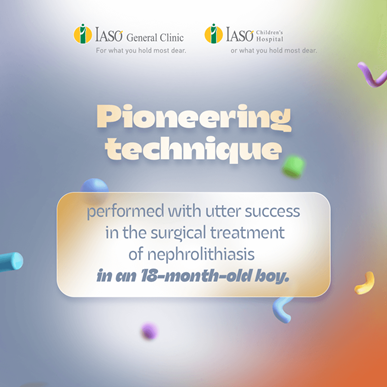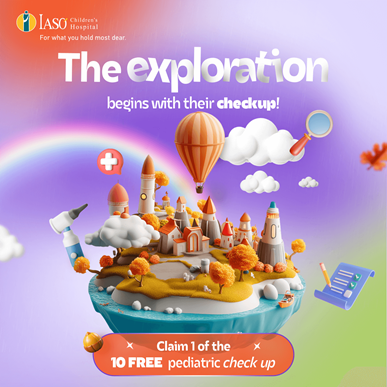
Hemangioma and Vascular Malformations Clinic
Diagnostic Sector
- The only Center in Greece for the diagnosis and comprehensive treatment of vascular malformations
- It collaborates with leading centers in the US and Europe, at both a research and clinical level, and the most advanced treatments are being applied
- It is staffed by a medical team of renowned and specialized doctors who have been trained in leading centers in the US and have extensive experience in the application of contemporary techniques and methods.
- It has innovative, state-of-the-art medical equipment so as to provide the most comprehensive & accurate imaging
- The Center’s Heads are: an Interventional Radiologist/Neuroradiologist, a Maxillofacial Surgeon, a Pediatric Hematologist/Oncologist, who collaborate with many medical specialties such as Pediatric Surgeons, Dermatologists, Otolaryngologists, Orthopedic Surgeons, Plastic Surgeons, Ophthalmologists, Vascular Surgeons, Geneticists with experience in treating patients with vascular malformations
- Τhe specialized team conducts a well-rounded assessment of patients and recommends the most appropriate therapeutic approach
What are vascular anomalies?
Vascular anomalies are caused by gene mutations, i.e. changes in DNA, which are mainly found in the affected tissues. They are divided into vascular tumors and malformations, according to the International Society for the Study of Vascular Anomalies (ISSVA). The therapeutic approach for patients having these conditions includes surgery (tumor/malformation removal), interventional radiology (sclerosing agent injection/vascular embolization) and pediatric hematology/oncology (administration of targeted therapy, treatment of bleeding and thrombotic predisposition). Diagnostic radiology, pathology, and numerous other medical specialties are also important due to the particularity of these conditions in each specific patient.
Different conditions observed:
Vascular Tumors
Infantile hemangioma:
The most common vascular anomaly (affecting 1 in 10 newborns). It is a benign tumor, which is usually observed and develops in the first weeks following the infant’s birth, with a maximum growth rate in the first months and gradual regression after the first year of life. Although in most cases it does not cause problems, depending on its location it may cause complications that require early treatment. It is diagnosed via clinical examination, while imaging tests and biopsy are also helpful. The use of a beta-blocker is common and effective in most patients who are in need of treatment, though it can be supplemented by surgical excision and sclerotherapy or embolization, depending on the symptoms.
Congenital hemangioma:
Unlike infantile hemangioma, this vascular tumor is at its maximum size before the baby is born. After the first four to six months after birth, it may begin to regress, or remain stable. Monitoring is required due to potential rupture. It is diagnosed via clinical examination, while imaging tests and biopsy are also helpful, mainly for differentiation from other entities such as Kaposiform hemangioendothelioma (KHE). Medication is not effective. Embolization and surgical excision are usually the recommended treatment methods.
Aggressive vascular tumors:
Kaposiform hemangioendothelioma (KHE): a rare disease that mainly affects toddlers and infants, where the vessels grow to such an extent that proteins which regulate coagulation such as fibrinogen and platelets are destroyed, leading to a high risk of hemorrhage. Diagnosis includes clinical and imaging findings, while the histological results are characteristic. Due to the risk of bleeding as well as other symptoms, one of which is pain, early treatment is of utmost importance and includes corticosteroids and immunosuppressants. In certain cases, embolization is deemed necessary as well.
Vascular Malformations:
They consist of Venous, Arterial, Capillary, Lymphatic and various combinations thereof, and can be findings in various syndromes.
They are mainly diagnosed via clinical examination and based on imaging findings. Biopsies are increasingly needed in order to confirm that the diagnosis is accurate and to find any mutations that can be targeted by medication.
Treatment generally includes interventional radiology with the injection of a sclerosing agent into the affected vessel, the use of medication (inhibitors of gene mutations related to the diagnosis, such as Sirolimus, Alpelisib, Trametinib), surgical excision or a combination of these. The cooperation of each patient with specialized doctors of various specialties remains particularly important. Moreover, the support of patients so as to deal with comorbidities (both physical and psychological) constitutes an integral part of the treatment.
Capillary Malformations (CMs):
They are low-flow vascular malformations in the capillaries of the skin and are red/pink stains that are usually located on one side of the body (contralateral) or in embryological segments. These lesions are observed after birth and grow at the same rate as the child. They require evaluation as they may be associated with syndromes such as Sturge-Webber syndrome, which predisposes to neurological and ophthalmological complications; Parkes Weber syndrome, which is associated with arteriovenous malformations; Klippel-Trenaunay syndrome, which consists of soft tissue hypertrophy, venous/lymphatic malformations. The genes involved are GNAQ1 and RASA1. The diagnosis is mainly based on the clinical picture but, depending on the location, imaging tests may be needed for other complications. Many skin lesions do not necessarily require treatment, but depending on the location and extent, the use of laser (pulsed dye laser) helps with discoloration. Treatment with inhibitors such as Sirolimus may be helpful in syndromes involving capillary malformation, but does not affect the color of the stain. Without treatment, these lesions tend to become thicker, perhaps nodular, over time.
Arteriovenous Malformations (AVMs):
They are rare, high-flow vascular malformations that may also appear as a lesion or as part of a syndrome. Although they are present at birth, they are often diagnosed at an older age. In children, they may appear as an erythema on the skin that becomes redder and increases in size over time. Initially, it can be confused with infantile hemangioma, but the progression is very different. Bleeding from the lesion, increase in size after trauma/ beginning of puberty/ pregnancy remain common, while on examination, a sensation of heat and, in advanced stages, pulsing, ulcers, pain may be observed. The diagnosis is based on the clinical picture and imaging tests such as ultrasound, MR/CT angiography. As treatment requires full excision or destruction of the focal point (nidus) of the malformation, which is not always possible, multiple sessions of embolization of the pathological vessels, as well as surgical interventions, are often required. The role of medication is not defined, although there are reports of the use of RASA1 inhibitors, which are associated with the formation of these malformations. Without timely treatment, these malformations continue to increase in size, causing tissue destruction, severe bleeding, pain and deformity. For these reasons, treatment at a young age is recommended.
Hereditary Hemorrhagic Telangiectasia (HHT) is a disorder that is inherited in an autosomal dominant manner, with the main mutations occurring in the ENG, ACVRL1, SMAD4, GDF2 genes. There is usually a delay in its diagnosis. In children, it mainly presents as nosebleeds, while the common telangiectasias in the fingers and lips, cerebral and gastrointestinal hemorrhages appear after the first decades of life. The arteriovenous malformations in this syndrome are located in the lungs, liver and brain and patients require lifelong monitoring with special protocols.
Capillary Malformation - AVM (Parkes Weber syndrome) is also a disorder that is inherited in an autosomal dominant manner and presents both capillary and arteriovenous malformations and hypertrophy of bones and soft tissues. Due to a mutation of RASA1, medication has been used, combined with embolization or surgical resection, if feasible.
Lymphatic Malformations (LMs):
They constitute a broad category of conditions, which is characterized by disorders in the embryological development of the lymphatic system. They can be classified into simple and complex, depending on their extent and characteristics.
Simple
Cysts with lymphatic fluid (and the presence of blood) are observed and may be large - usually over 5 mm (macrocystic) or small in size (microcystic) or combined. Most patients are diagnosed during infancy (even prenatally) although some lesions may be observed at an older age. The cysts grow “at the same rate as the child” and do not regress. They mainly appear on the head/ neck where they may obstruct the airway/ breathing or swallowing. They cause chronic secretion of pleural fluid in the chest, while also causing protein malabsorption in the intestine. The skin covering the lesions may have a bluish hue or have small skin-colored blisters that secrete lymphatic fluid and predispose to infection. Infections are the most common cause of death, while bleeding into the cyst causes pain, edema and anemia, when it is severe or chronic.
It is mainly diagnosed via clinical examination, but MRI is also important, as it aids with the diagnosis, reveals the size of the cysts and their relation to normal structures, and provides the best approach.
Treatment is given to lesions that cause symptoms such as pain, or threaten the proper body function. Lymphedema is treated with elastic bandages. Infection control remains crucial. Sclerosing agent injection (sclerotherapy) into large or combined cysts is the first-line treatment, effective in controlling the condition, although multiple sessions are usually needed over time. Surgical excision is decided according to the clinical picture of each patient.
Complex
Complex lymphatic anomalies (CLAs) are characterized by clinical syndromes. We will refer to Generalized Lymphatic Anomaly (GLA), Kaposiform Lymphatic Anomaly (KLA), Gorham-Stout Disease (GSD), Central Conducting Lymphatic Anomaly (CCLA). These conditions are rare and usually appear in children and young adults.
The clinical and imaging findings support the diagnosis, but biopsy helps in verification, with particular care for it to be taken from a spot that does not lead to the excretion of lymphatic fluid, such as, for example, from a rib.
GLA, previously known as Lymphangiomatosis, refers to the development of enlarged lymphatic vessels usually in the bones (medullary part), liver, spleen, mediastinum, lungs.
KLA is a recent entity, it is histologically differentiated from GLA and is found mainly in the thoracic cavity, characterized by the fact that the lymphatic fluid is often accompanied by bleeding, coagulation disorders and low platelets.
GSD is characterized by osteolysis in the cortex of the ribs and skull.
CCLA essentially refers to cases of lymphatic vessel atresia, resulting in areas of mechanical obstruction of the flow of lymphatic fluid.
Treating these conditions remains a challenge because it is not possible for them to be cured, due to the extent of the disease. Supportive care includes the use of surgical/ invasive treatments as well as medications. Sirolimus (off-label) has been used successfully, as have bisphosphonates for the treatment of osteolysis. Latest data support the use of Alpelisib, as a PIK3CA inhibitor.
Venous Malformations (VMs):
Sporadic venous malformations are usually focal, localized and affecting mainly the head, neck and extremities. The common mutations are found in the TIE2 gene and lead to venous developmental anomalies (DVAs). Although they are present at birth, they may not be apparent until reaching an older age. The lesions are soft and compressible with a bluish hue and increase in size with gravity. The lesions grow “at the same rate as the child”. Common complications include pain and inflammation due to the development of phleboliths. In large lesions, coagulation disorders with low fibrinogen and high fibrinogen degradation products (d-dimer) may be observed.
Treatment includes the use of elastic bandages, surgical excision if possible and sclerotherapy/ vessel embolization, especially if there is a risk of deep vein thrombosis (DVT). There are also specific indications for the use of anticoagulants.
Glomuvenous malformations (GVMs) are multifocal and develop in an autosomal dominant manner due to mutations in the GLMN gene and they are characterized by hyperkeratosis and a blue color. The lesions are located in the skin and subcutaneous tissue and they are painful, while not compressible. Microthromboses are not observed. They appear after birth and grow over time. Magnetic resonance imaging remains useful for determining the lesions’ relation to other structures. Surgical excision is the main type of treatment.
GVM must be differentiated from Blue Rubber Bleb Nevus Syndrome (BRBNS) which is characterized by multiple, often painful, cutaneous blue lesions, which also affect the intestine and lead to bleeding. Microthromboses are common. Endoscopies are important when making the diagnosis, as well as checking for possible brain lesions. Treatment includes surgical excision, if possible, especially for skin lesions that are painful and bleeding, together with the use of the mTOR inhibitor, Sirolimus.
Coagulation Disorders
Low-flow malformations, such as venous malformations, and some tumors (ΚΗΕ) are characterized by coagulation disorders due to platelet consumption and coagulation factors in the lumen of the abnormal vessels. These changes can lead to bleeding or the formation of clots which cause pain and a reduced quality of life. The use of anticoagulants helps in symptom management.
Pharmaceutical Therapies
For patients with infantile hemangiomas requiring treatment, propranolol is a beta-blocker that has been extensively studied and is approved for this particular indication. Discoveries regarding the pathogenesis of many vascular malformations are progressing rapidly and have identified mutations in implicated genes. Targeted therapies against the mTOR, RAS/MAPK, PIK3CA molecular pathways are being studied and used in patients in combination with interventional approaches. Although these therapies are currently considered “off-label” for patients with vascular anomalies, the experience gathered with regard to their administration with clinical and imaging response has been increased.
Minimally Invasive Interventional Radiology Techniques for venous and lymphatic malformations
Sclerotherapy
It is applied internationally as the method of choice in the majority of venous and lymphatic malformations. As a minimally invasive method, it has minor complications and high rates of clinical response (75-90% of patients).
This method involves the percutaneous puncture of the vascular malformation and the injection of special pharmaceutical agents aiming for the permanent destruction of the pathological veins. The selection of the most suitable pharmaceutical agent is made by the medical specialist for optimal results.
Sclerotherapy is ideally performed by specialized interventional radiologists with the aid of an angiography unit and ultrasound machine in a specially designed room.
Bleomycin ElectroScleroTherapy (BEST)
Bleomycin electrosclerotherapy is the latest development in the treatment of vascular malformations. It is a completely new method that has been applied since 2019 in a few specialized centers. IASO is one of the first centers on a global basis to apply electrosclerotherapy, with an abundance of clinical experience.
This method is mainly indicated for the treatment of low-flow vascular malformations (venous and lymphatic malformations) as well as selected cases of arteriovenous malformations.
Our clinical experience so far has shown that this method significantly reduces the number of sessions required.
With electrosclerotherapy, the effectiveness of sclerotherapy can be increased and the dose of the administered medication (Bleomycin) can be reduced.
The procedure is performed under general anesthesia. First, the sclerosing agent is administered either directly into the vascular malformation, following its puncture, or intravenously. Subsequently, thin needles are placed into the vascular malformation, usually with ultrasound and fluoroscopic guidance. These needles are connected to the electric pulse generator. By applying short electric pulses, the permeability of the cell membrane of the cells that form the wall of the vascular malformation is increased, resulting in a dramatic increase in the intracellular concentration of Bleomycin.
Surgical removal of venous and lymphatic malformationsUsually, it is not the first choice due to the difficulty of completely removing the venous or lymphatic malformation and the increased complications compared to sclerotherapy. However, there are cases where surgical removal is the method of choice, such as when the deformity remains following the sclerotherapy procedure or in cases of limited extent of venous malformations as well as superficial lesions. It is also indicated in cases in which the gastrointestinal tract is affected.
Minimally Invasive Interventional Radiology Techniques for arteriovenous malformations
Embolization
It involves the occlusion of pathological vessels with solid (coils) or liquid embolic agents (such as Onyx, NBCA GLUE). Depending on the location of the arteriovenous malformation and its morphology, embolization is performed intravascularly using catheters or percutaneously by direct puncture of the arteriovenous malformation.
Surgical removal of arteriovenous malformations
It is applied in combination with embolization for better long-term results, in cases when it is technically feasible.
- Prof. Milton Waner, Otolaryngologist, Vascular Birthmark Institute of New York
- Dr. Aaron Fay, Ophthalmic Plastic Surgery, Ophthalmic Oncology
- Dr. Teresa O, Otolaryngologist, Vascular Birthmark Institute of New York
- Ioannis Konstantinidis, Plastic Surgeon - Cosmetic, Plastic & Reconstructive Surgery









